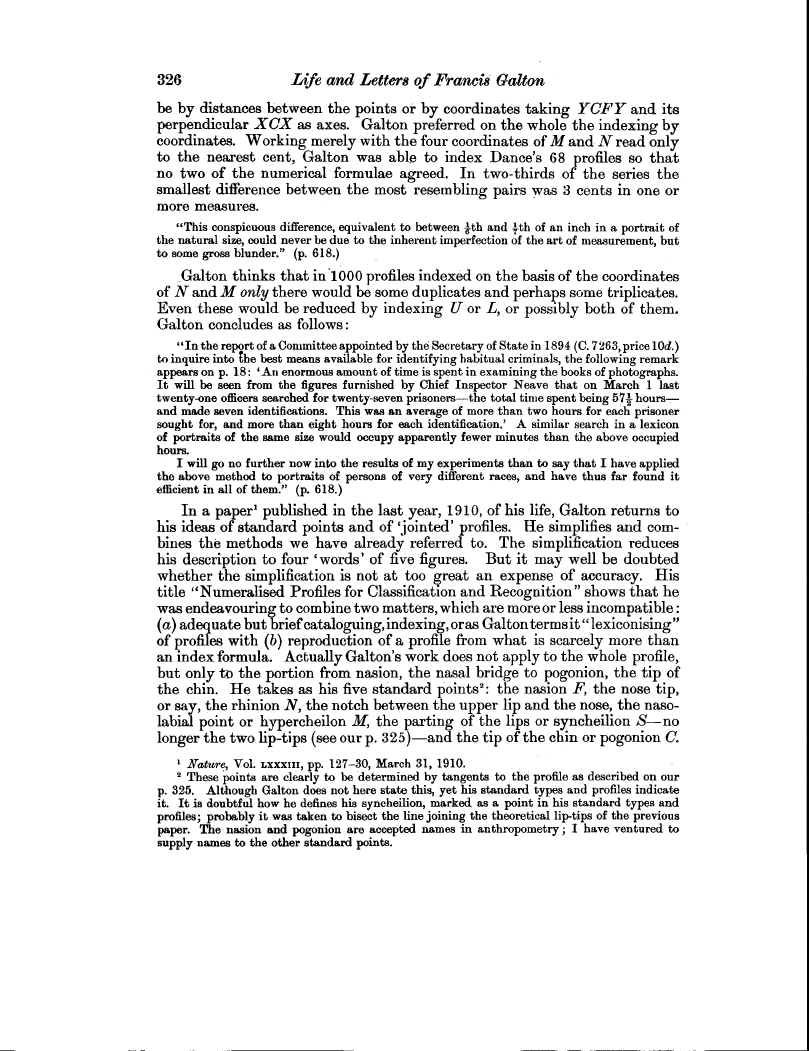326 Life and Letters of Francis Galton
be by distances between the points or by coordinates taking YCFY and its perpendicular XCX as axes. Galton preferred on the whole the indexing by coordinates. Working merely with the four coordinates of M and N read only to the nearest cent, Galton was able to index Dance's 68 profiles so that no two of the numerical formulae agreed. In two-thirds of the series the smallest difference between the most resembling pairs was 3 cents in one or more measures.
"This conspicuous difference, equivalent to between 2th and I th of an inch in a portrait of the natural size, could never be due to the inherent imperfection of the art of measurement, but to some gross blunder." (p. 618.)
Galton thinks that in 1000 profiles indexed on the basis of the coordinates of N and M only there would be some duplicates and perhaps some triplicates. Even these would be reduced by indexing U or L, or possibly both of them. Galton concludes as follows
"In the report of a Committee appointed by the Secretary of State in 1894 (C. 7263, price 10d.) to inquire into the best means available for identifying habitual criminals, the following remark appears on p. 18: `An enormous amount of time is spent in examining the books of photographs.
It will be seen from the figures furnished by Chief Inspector Neave that on March 1 last twenty-one officers searched for twenty-seven prisoners-the total time spent being 572 hoursand made seven identifications. This was an average of more than two hours for each prisoner sought for, and more than eight hours for each identification.' A similar search in a lexicon of portraits of the same size would occupy apparently fewer minutes than the above occupied hours.
I will go no further now into the results of my experiments than to say that I have applied the above method to portraits of persons of very different races, and have thus far found it efficient in all of them." (p. 618.)
In a paper" published in the last year, 1910, of his life, Galton returns to his ideas of standard points and of `jointed' profiles. He simplifies and combines the methods we have already referred to. The simplification reduces his description to four `words' of five figures. But it may well be doubted whether the simplification is not at too great an expense of accuracy. His title "Numeralised Profiles for Classification and Recognition" shows that he was endeavouring to combine two matters, which are more or less incompatible (a) adequate but brief cataloguing, indexing, or as Galton terms it " lexiconising " of profiles with (b) reproduction of a profile from what is scarcely more than an index formula. Actually Galton's work does not apply to the whole profile, but only to the portion from nasion, the nasal bridge to pogonion, the tip of the chin. He takes as his five standard points2: the nasion F, the nose tip, or say, the rhinion N, the notch between the upper lip and the nose, the nasolabial point or hypercheilon M, the parting of the lips or syncheilion S-no longer the two lip-tips (see our p. 325)-and the tip of the chin or pogonion C.
" Nature, Vol. LXXXIII, pp. 127-30, March 31, 1910.
2 These points are clearly to be determined by tangents to the profile as described on our p. 325. Although Galton does not here state this, yet his standard types and profiles indicate it. It is doubtful how he defines his syncheilion, marked, as a point in his standard types and profiles; probably it was taken to bisect the line joining the theoretical lip-tips of the previous paper. The nasion and pogonion are accepted names in anthropometry ; I have ventured to supply names to the other standard points.

